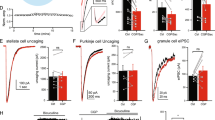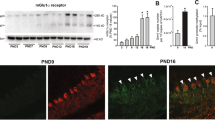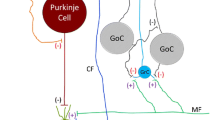Abstract
The effect of kainate, an agonist selective for ionotropic AMPA/kainate type of glutamate receptors, on GABAA receptor subunit expression in cultured mouse cerebellar granule cells was studied using quantitative RT-PCR, ligand binding and electrophysiology. Chronic kainate treatment, without producing excitotoxicity, resulted in preferential, dose- and time-dependent down-regulation of αl, α6 and β2 subunit mRNA expression, the expression of β3, γ2 and δ subunit mRNAs being less affected. The down-regulation was reversed by DNQX, an AMPA/kainate-selective glutamate receptor antagonist. A 14-day kainate treatment resulted in 46% decrease of total [3H]Ro 15-4513 binding to the benzodiazepine sites. Diazepam-insensitive [3H]Ro 15-4513 binding was decreased by 89% in accordance with very low amount of α6 subunit mRNA present. Diazepam-sensitive [3H]Ro 15-4513 binding was decreased only by 40%, contrasting > 90% decrease in α1 subunit mRNA expression. However, this was consistent with lower potentiation of GABA-evoked currents in kainate-treated than control cells by the α1-selective benzodiazepine site ligand zolpidem, suggesting compensatory expression of α5 (and/or α2 or α3) subunits producing diazepam-sensitive but zolpidem-insensitive receptor subtypes. In conclusion, chronic kainate treatment of cerebellar granule cells selectively down-regulates α1, α6 and β2 subunits resulting in altered GABAA receptor pharmacology.
Similar content being viewed by others
References
Wisden W, Korpi ER, Bahn S. The cerebellum: a model system for studying GABAA receptor diversity. Neuropharmacology 1996; 35: 1139–1160.
Sieghart W. Structure and pharmacology of gamma-aminobutyric acidA receptor subtypes. Pharmacol Rev 1995; 47: 181–234.
Korpi ER, Grunder G, Lüddens H. Drug interactions at GABAA receptors. Prog Neurobiol 2002; 67: 113–159.
Laurie DJ, Seeburg PH, Wisden W. The distribution of 13 GABAA receptor subunit mRNAs in the rat brain. II. Olfactory bulb and cerebellum. J Neurosci 1992; 12: 1063–1076.
Jechlinger M, Pelz R, Tretter V, Klausberger T, Sieghart W. Subunit composition and quantitative importance of heterooligomeric receptors: GABAA receptors containing alpha6 subunits. J Neurosci 1998; 18: 2449–2457.
Quirk K, Whiting PJ, Ragan CI, McKernan RM. Characterisation of δ-subunit containing GABAA receptors from rat brain. Eur J Pharmacol 1995; 290: 175–181.
Korpi ER, Seeburg PH. Natural mutation of GABAA receptor α6 subunit alters benzodiazepine affinity but not allosteric GABA effects. Eur J Pharmacol 1993; 247: 23–27.
Korpi ER, Koikkalainen P, Vekovischeva OY, Makela R, Kleinz R, Uusi-Oukari M, et al. Cerebellar granule-cell-specific GABAA receptors attenuate benzodiazepine-induced ataxia: evidence from alpha 6-subunit-deficient mice. Eur J Neurosci 1999; 11: 233–240.
Levi G, Aloisi F, Ciotti MT, Gallo V. Autoradiographic localization and depolarization-induced release of acidic amino acids in differentiating cerebellar granule cell cultures. Brain Res 1984; 290: 77–86.
Carlson BX, Elster L, Schousboe A. Pharmacological and functional implications of developmentally-regulated changes in GABAA receptor subunit expression in the cerebellum. Eur J Pharmacol 1998; 352: 1–14.
Grayson DR, Zhu W, Harris BT, Vicini S, Zheng T. Differentially expressed GABAA-receptor subunits result in structurally and functionally altered receptor assemblies following excitatory afferent synaptic transmission. Perspect Dev Neurobiol 1998; 5: 193–205.
Laurie DJ, Wisden W, Seeburg PH. The distribution of thirteen GABAA receptor subunit mRNAs in the rat brain. III. Embryonic and postnatal development. J Neurosci 1992; 12: 4151–4172.
Zheng TM, Zhu WJ, Puia G, Vicini S, Grayson DR, Costa E, et al. Changes in gamma-aminobutyrate type A receptor subunit mRNAs, translation product expression, and receptor function during neuronal maturation in vitro. Proc Natl Acad Sci USA 1994; 91: 10952–10956.
Zheng T, Santi MR, Bovolin P, Marlier LN, Grayson DR. Developmental expression of the alpha 6 GABAA receptor subunit mRNA occurs only after cerebellar granule cell migration. Dev Brain Res 1993; 75: 91–103.
Behringer KA, Gault LM, Siegel RE. Differential regulation of GABAA receptor subunit mRNAs in rat cerebellar granule neurons: importance of environmental cues. J Neurochem 1996; 66: 1347–1353.
Gallo V, Kingsbury A, Balazs R, Jorgensen OS. The role of depolarization in the survival and differentiation of cerebellar granule cells in culture. J Neurosci 1987; 7: 2203–2213.
Balazs R, Gallo V, Kingsbury A. Effect of depolarization on the maturation of cerebellar granule cells in culture. Brain Res 1988; 468: 269–276.
Memo M, Bovolin P, Costa E, Grayson DR. Regulation of gammaaminobutyric acidA receptor subunit expression by activation of Nmethyl-D-aspartate-selective glutamate receptors. Mol Pharmacol 1991; 39: 599–603.
Harris BT, Charlton ME, Costa E, Grayson DR. Quantitative changes in alpha 1 and alpha 5 gamma-aminobutyric acid type A receptor subunit mRNAs and proteins after a single treatment of cerebellar granule neurons with N-methyl-D-aspartate. Mol Pharmacol 1994; 45: 637–648.
Gault LM, Siegel RE. Expression of the GABA receptor delta subunit is selectively modulated by depolarization in cultured rat cerebellar granule neurons. J Neurosci 1997; 17: 2391–2399.
Gault LM, Siegel RE. NMDA receptor stimulation selectively initiates GABAA receptor delta subunit mRNA expression in cultured rat cerebellar granule neurons. J Neurochem 1998; 70: 1907–1915.
Hack NJ, Sluiter AA, Balazs R. AMPA receptors in cerebellar granule cells during development in culture. Dev Brain Res 1995; 87: 55–61.
Pemberton KE, Belcher SM, Ripellino JA, Howe JR. High-affinity kainate-type ion channels in rat cerebellar granule cells. J Physiol 1998; 510: 401–420.
Sattler R, Tymianski M. Molecular mechanisms of glutamate receptor-mediated excitotoxic neuronal cell death. Mol Neurobiol 2001; 24: 107–129.
Ben-Ari Y, Cossart R. Kainate a double agent that generates seizures: two decades of progress. Trends Neurosci 2000; 23: 580–587.
Sperk G, Schwarzer C, Tsunashima K, Kandlhofer S. Expression of GABAA receptor subunits in the hippocampus of the rat after kainic acid-induced seizures. Epilepsy Res 1998; 32: 129–139.
Herndon RM, Coyle JT. Selective destruction of purkinje cells, basket-stellate cells, and golgi type II cells of the cerebellum by kainic acid: further evidence that glutamate is the granule cell transmitter. Trans Am Neurol Assoc 1977; 102: 93–96.
Garthwaite J, Wilkin GP. Kainic acid receptors and neurotoxicity in adult and immature rat cerebellar slices. Neuroscience 1982; 7: 2499–2514.
Drejer J, Schousboe A. Selection of a pure cerebellar granule cell culture by kainate treatment. Neurochem Res 1989; 14: 751–754.
Balazs R, Hack N, Jorgensen OS. Interactive effects involving different classes of excitatory amino acid receptors and the survival of cerebellar granule cells in culture. Int J Dev Neurosci 1990; 8: 347–359.
Damgaard I, Trenkner E, Sturman JA, Schousboe A. Effect of K+- and kainate-mediated depolarization on survival and functional maturation of GABAergic and glutamatergic neurons in cultures of dissociated mouse cerebellum. Neurochem Res 1996; 21: 267–275.
Meier E, Drejer J, Schousboe A. GABA induces functionally active low-affinity GABA receptors on cultured cerebellar granule cells. J Neurochem 1984; 43: 1737–1744.
Messer A. The maintenance and identification of mouse cerebellar granule cells in monolayer culture. Brain Res 1977; 130: 1–12.
Holopainen I, Malminen O, Kontro P. Sodium-dependent high-affinity uptake of taurine in cultured cerebellar granule cells and astrocytes. J Neurosci Res 1987; 18: 479–483.
Malminiemi O, Korpi ER. Diazepam-insensitive [3H]Ro 15-4513 binding in intact cultured cerebellar granule cells. Eur J Pharmacol 1989; 169: 53–60.
Jones A, Korpi ER, McKernan RM, Pelz R, Nusser Z, Makela R, etal. Ligand-gated ion channel subunit partnerships: GABAA receptor alpha6 subunit gene inactivation inhibits delta subunit expression. J Neurosci 1997; 17: 1350–1362.
Uusi-Oukari M, Kleinz R, Makela R, Lüddens H, Korpi ER. Quantification of GABAA receptor subunit mRNAs by non-radioisotopic competitive RT-PCR utilizing plate-based EIA methodology. J Neurosci Methods 2000; 95: 65–73.
Chomczynski P, Sacchi N. Single-step method of RNA isolation by acid guanidinium thiocyanate-phenol-chloroform extraction. Anal Biochem 1987; 162: 156–159.
Mosmann T. Rapid colorimetric assay for cellular growth and survival: application to proliferation and cytotoxicity assays. J Immunol Methods 1983; 65: 55–63.
Denizot F, Lang R. Rapid colorimetric assay for cell growth and survival. Modifications to the tetrazolium dye procedure giving improved sensitivity and reliability. J Immunol Methods 1986; 89: 271–277.
Bradford MM. A rapid and sensitive method for the quantitation of microgram quantities of protein utilizing the principle of proteindye binding. Anal Biochem 1976; 72: 248–254.
Mellor JR, Merlo D, Jones A, Wisden W, Randall AD. Mouse cerebellar granule cell differentiation: electrical activity regulates the GABAA receptor alpha 6 subunit gene. J Neurosci 1998; 18: 2822–2833.
Mogensen HS, Hack N, Balazs R, Jorgensen OS. The survival of cultured mouse cerebellar granule cells is not dependent on elevated potassium-ion concentration. Int J Dev Neurosci 1994; 12: 451–460.
Engblom AC, Johansen FF, Kristiansen U. Actions and interactions of extracellular potassium and kainate on expression of 13 gamma-aminobutyric acid type A receptor subunits in cultured mouse cerebellar granule neurons. J Biol Chem 2003; 278: 16543–16550.
Ives JH, Drewery DL, Thompson CL. Neuronal activity and its influence on developmentally regulated GABAA receptor expression in cultured mouse cerebellar granule cells. Neuropharmacology 2002; 43: 715–725.
Bulleit RF, Hsieh T. MEK inhibitors block BDNF-dependent and -independent expression of GABAA receptor subunit mRNAs in cultured mouse cerebellar granule neurons. Dev Brain Res 2000; 119: 1–10.
Kato K, Puttfarcken PS, Lyons WE, Coyle JT. Developmental time course and ionic dependence of kainate-mediated toxicity in rat cerebellar granule cell cultures. J Pharmacol Exp Ther 1991; 256: 402–411.
Resink A, Hack N, Boer GJ, Balazs R. Growth conditions differentially modulate the vulnerability of developing cerebellar granule cells to excitatory amino acids. Brain Res 1994; 655: 222–232.
Belcher SM, Howe JR. Characterization of RNA editing of the glutamate-receptor subunits GluR5 and GluR6 in granule cells during cerebellar development. Mol Brain Res 1997; 52: 130–138.
Ripellino JA, Neve RL, Howe JR. Expression and heteromeric interactions of non-N-methyl-D-aspartate glutamate receptor subunits in the developing and adult cerebellum. Neuroscience 1998; 82: 485–497.
Mogensen HS, Jorgensen OS. AMPA receptor subunit mRNAs and intracellular [Ca2+] in cultured mouse and rat cerebellar granule cells. Int J Dev Neurosci 2000; 18: 61–68.
Gallo V, Giovannini C, Levi G. Depression by sodium ions of calcium uptake mediated by non-N-methyl-D-aspartate receptors in cultured cerebellar neurons and correlation with evoked D-[3H]aspartate release. J Neurochem 1992; 58: 406–415.
Savidge JR, Bleakman D, Bristow DR. Identification of kainate receptor-mediated intracellular calcium increases in cultured rat cerebellar granule cells. J Neurochem 1997; 69: 1763–1766.
Giardina SF, Beart PM. Kainate receptor-mediated apoptosis in primary cultures of cerebellar granule cells is attenuated by mitogen-activated protein and cyclin-dependent kinase inhibitors. Br J Pharmacol 2002; 135: 1733–1742.
Griffiths R, Malcolm C, Ritchie L, Frandsen A, Schousboe A, Scott M, et al. Association of c-fos mRNA expression and excitotoxicity in primary cultures of mouse neocortical and cerebellar neurons. J Neurosci Res 1997; 48: 533–542.
Chiang LW, Grenier JM, Ettwiller L, Jenkins LP, Ficenec D, Martin J, et al. An orchestrated gene expression component of neuronal programmed cell death revealed by cDNA array analysis. Proc Natl Acad Sci USA 2001; 98: 2814–2819.
Cheung NS, Carroll FY, Lärm JA, Beart PM, Giardina SF. Kainate-induced apoptosis correlates with c-Jun activation in cultured cerebellar granule cells. J Neurosci Res 1998; 52: 69–82.
Sassone-Corsi P, Ransone LJ, Lamph WW, Verma IM. Direct interaction between fos and jun nuclear oncoproteins: role of the ‘leucine zipper’ domain. Nature 1988; 336: 692–695.
Karin M, Liu Z, Zandi E. AP-1 function and regulation. Curr Opin Cell Biol 1997; 9: 240–246.
Johnston GA, Kennedy SM, Twitchin B. Action of the neurotoxin kainic acid on high affinity uptake of L-glutamic acid in rat brain slices. J Neurochem 1979; 32: 121–127.
Lodge D, Johnston GA, Curtis DR, Bornstein JC. Kainate neurotoxicity and glutamate inactivation. Neurosci Lett 1979; 14: 343–348.
Gegelashvili G, Schousboe A. High affinity glutamate transporters: regulation of expression and activity. Mol Pharmacol 1997; 52: 6–15.
Danbolt NC. Glutamate uptake. Prog Neurobiol 2001; 65: 1–105.
Rogers KL, Philibert RA, Dutton GR. Glutamate receptor agonists cause efflux of endogenous neuroactive amino acids from cerebellar neurons in culture. Eur J Pharmacol 1990; 177: 195–199.
Simonian NA, Getz RL, Leveque JC, Konradi C, Coyle JT. Kainic acid induces apoptosis in neurons. Neuroscience 1996; 75: 1047–1055.
Ha BK, Vicini S, Rogers RC, Bresnahan JC, Burry RW, Beattie MS. Kainate-induced excitotoxicity is dependent upon extracellular potassium concentrations that regulate the activity of AMPA/ KA type glutamate receptors. J Neurochem 2002; 83: 934–945.
Favaron M, Manev H, Alho H, Bertolino M, Ferret B, Guidotti A, et al. Gangliosides prevent glutamate and kainate neurotoxicity in primary neuronal cultures of neonatal rat cerebellum and cortex. Proc Natl Acad Sci USA 1988; 85: 7351–7355.
Manev H, Favaron M, Guidotti A, Costa E. Delayed increase of Ca2+ influx elicited by glutamate: role in neuronal death. Mol Pharmacol 1989; 36: 106–112.
Balazs R, Hack N, Jorgensen OS. Selective stimulation of excitatory amino acid receptor subtypes and the survival of cerebellar granule cells in culture-effect of kainic acid. Neuroscience 1990; 37: 251–258.
Van der Valk JB, Resink A, Balazs R. Membrane depolarization and the expression of glutamate receptors in cerebellar granule cells. Eur J Pharmacol 1991; 201: 247–250.
Pizzi M, Fallacara C, Arrighi V, Memo M, Spano PF. Attenuation of excitatory amino acid toxicity by metabotropic glutamate receptor agonists and aniracetam in primary cultures of cerebellar granule cells. J Neurochem 1993; 61: 683–689.
Facchinetti F, Hack NJ, Balazs R. Calcium influx via ionotropic glutamate receptors causes long lasting inhibition of metabotropic glutamate receptor-coupled phosphoinositide hydrolysis. Neurochem Int 1998; 33: 263–270.
Chen Q, Moulder K, Tenkova T, Hardy K, Olney JW, Romano C. Excitotoxic cell death dependent on inhibitory receptor activation. Exp Neurol 1999; 160: 215–225.
Uusi-Oukari M, Heikkilä J, Sinkkonen ST, Mäkelä R, Hauer B, Homanics GE, et al. Long-range interactions in neuronal gene expression: evidence from gene targeting in the GABAA receptor β2-α6-α1-γ2 subunit gene cluster. Mol Cell Neurosci 2000; 16: 34–41.
Garrett KM, Haque D, Berry D, Niekrasz I, Gan J, Rotter A, et al. The GABAA receptor alpha 6 subunit gene (Gabra6) is tightly linked to the α1-γ2 subunit cluster on mouse chromosome 11. Mol Brain Res 1997; 45: 133–137.
Chapman AG. Glutamate receptors in epilepsy. Prog Brain Res 1998; 116: 371–383.
Dirnagl U, Iadecola C, Moskowitz MA. Pathobiology of ischaemic stroke: an integrated view. Trends Neurosci 1999; 22: 391–397.
Dodd PR, Beckmann AM, Davidson MS, Wilce PA. Glutamatemediated transmission, alcohol, and alcoholism. Neurochem Int 2000; 37: 509–533.
Author information
Authors and Affiliations
Corresponding author
Additional information
The first two authors have equally contributed to this study.
Rights and permissions
About this article
Cite this article
Martikainen, I.K., Lauk, K., Möykkynen, T. et al. Kainate down-regulates a subset of GABAA receptor subunits expressed in cultured mouse cerebellar granule cells. Cerebellum 3, 27–38 (2004). https://doi.org/10.1080/14734220310020876
Received:
Accepted:
Issue Date:
DOI: https://doi.org/10.1080/14734220310020876




